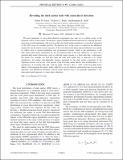Revealing the dark matter halo with axion direct detection
Author(s)
Foster, Joshua W.; Safdi, Benjamin R.; Rodd, Nicholas Llewellyn
DownloadPhysRevD.97.123006.pdf (1.556Mb)
PUBLISHER_POLICY
Publisher Policy
Article is made available in accordance with the publisher's policy and may be subject to US copyright law. Please refer to the publisher's site for terms of use.
Terms of use
Metadata
Show full item recordAbstract
The next generation of axion direct-detection experiments may rule out or confirm axions as the dominant source of dark matter. We develop a general likelihood-based framework for studying the time-series data at such experiments, with a focus on the role of dark matter astrophysics, to search for signatures of the QCD axion or axionlike particles. We illustrate how in the event of a detection the likelihood framework may be used to extract measures of the local dark matter phase-space distribution, accounting for effects such as annual modulation and gravitational focusing, which is the perturbation to the dark matter phase-space distribution by the gravitational field of the Sun. Moreover, we show how potential dark matter substructure, such as cold dark matter streams or a thick dark disk, could impact the signal. For example, we find that when the bulk dark matter halo is detected at 5σ global significance, the unique time-dependent features imprinted by the dark matter component of the Sagittarius stream, even if only a few percent of the local dark matter density, may be detectable at ∼2σ significance. A corotating dark disk, with lag speed ∼50 km/s, that is ∼20% of the local dark matter density could dominate the signal, while colder but as-of-yet unknown substructure may be even more important. Our likelihood formalism, and the results derived with it, are generally applicable to any time-series-based approach to axion direct detection.
Date issued
2018-06Department
Massachusetts Institute of Technology. Center for Theoretical PhysicsJournal
Physical Review D
Publisher
American Physical Society
Citation
Foster, Joshua W. et al. "Revealing the dark matter halo with axion direct detection." Physical Review D 81, 5 (March 2010): 052006 © 2010 American Physical Society
Version: Final published version
ISSN
2470-0010
2470-0029